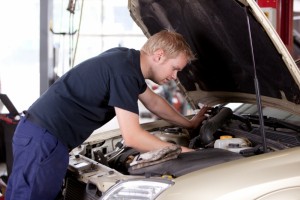Original, Aftermarket, Re-manufactured, Rebuilt, and Used parts, that is.
When repairing your car, we select parts from a variety of sources and the choice is based on a thoughtful and thorough process. If you sit in our waiting room and overhear Mike or Tom on the phone with a parts house, you may think it’s a simple undertaking for him to order a set of spark plugs or a headlamp assembly for the car on the lift in the shop. In reality, a great deal of time, expertise, and understanding have gone into the decision-making process for each and every part that we stock or order as we work on your vehicle. With the collective experience of our technicians & service-writers behind us, we can provide you with the best possible value on every repair we undertake.
Here’s a behind-the-scenes look at how we determine the best parts to use for a range of repairs and maintenance. To learn more, read on:
OEM (Original Equipment Manufacturer) Parts
- We purchase these parts directly from dealerships.
- These are the exact parts used when your vehicle was built.
Aftermarket parts made to OEM Specifications
- These parts are made to the original manufacturer’s specifications and typically function in exactly the same way the original parts do, they are simply made by a different manufacturer.
- Sometimes they are even made by the same manufacturer but under a different brand name, therefore only the name on the box is different.
- Example: Toyota owns a parts manufacturer called Denso. Denso makes all the spark plugs for Toyota and their subsidiary companies. Consumers can buy Denso spark plugs for a fraction of the price of the Toyota brand despite them being identical. The part is literally the same exact part made in the same exact plant and only the name on the box differs.
Innovative aftermarket parts
- Some aftermarket companies have created a niche for themselves by improving on issues in the original parts design.
- This option offers solutions for notorious issues that plague certain makes and models.
Remanufactured parts
- These are previously-used parts or “cores” that have been remanufactured to the original blue prints and manufacturer’s specifications.
- Once remanufactured, the parts are put through the same testing process that the original part was put through when it was made.
- In certain applications, remanufactured parts dominate the market.
Rebuilt parts
- With rebuilt parts, the cause of failure is identified and resolved – only the failed components are fixed before the overall part is resold.
- In this instance, it’s important to be mindful that other age-related issues may remain, unrelated to the immediate reason for failure.
Used parts
- These parts were used on a previous vehicle and are typically purchased as-is.
- When we purchase used engines and transmissions from trustworthy vendors, the parts are usually tested briefly before being shipped out.
- It is always a good idea to purchase additional parts & labor warranties when using these parts, therefore we typically purchase a full year of parts & labor coverage in these instances.
- In many applications, repairing a vehicle with used parts is by far the most affordable option.
If you have any questions about our process or about your vehicle’s replacement parts specifically, please contact us and we will be happy to provide you with personalized advice.
In addition to helping you find the best parts for your repairs, we can ensure your vehicle remains safe and reliable with our comprehensive maintenance services. Our service advisers will be happy to assist you — make an appointment by calling 215-295-4535 or visit www.bigoakcitgo.com to make an online appointment request.

